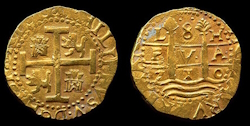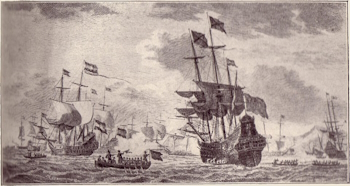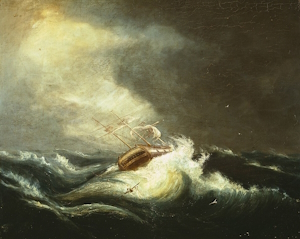 On 31st July 1715 a Spanish treasure fleet sank during a hurricane off the east coast of Florida. It was a catastrophe for the Spanish Crown, which was heavily relying on its cargo. The galleons were fully loaded with precious cargoes of gold, silver, jewellery, tobacco, spices, indigo, cochineal etc. The Spanish government was relying its the safe arrival, as the War of Spanish Succession, which had hindered the sailing of the treasure fleets, had just come to an end. For obvious reasons, this disaster awoke the interest of pirates, privateers, and honest seamen alike.
On 31st July 1715 a Spanish treasure fleet sank during a hurricane off the east coast of Florida. It was a catastrophe for the Spanish Crown, which was heavily relying on its cargo. The galleons were fully loaded with precious cargoes of gold, silver, jewellery, tobacco, spices, indigo, cochineal etc. The Spanish government was relying its the safe arrival, as the War of Spanish Succession, which had hindered the sailing of the treasure fleets, had just come to an end. For obvious reasons, this disaster awoke the interest of pirates, privateers, and honest seamen alike.
The Spanish treasure fleets
 Treasure fleets consisting of a dozen or more ships used to sail from Cádiz or Seville in Spain, bringing European goods not readily available in the New World to the colonies with the aim of returning with gold, silver and other goods from Peru and Colombia, as well as spices and other items from south east Asia, brought across the Pacific by the Manila Galleon, which was then transported by mule train across the isthmus of Panama. The fleet first arrived in Vera Cruz before sailing to Cartagena. The commanders of the ships had to wait until the next year to sail back in order to avoid the hurricane season, which was typically between June and November. Spanish galleons began sailing in fleets with escorts from 1555, after French corsairs attacked Havana, until the end of the 18th century, bringing much needed wealth, including gold and silver, to Spain. With the increase in the number of French, Dutch, and English pirates and privateers the convoy system became increasingly necessary. Spain’s economy was dependant on these yearly treasure fleets. Not producing many goods themselves, the Spanish needed the gold and silver to by products from other countries. Unfortunately for the Spanish, the treasure fleets were not only susceptible to pirates, but also to the weather. Dozens of treasure ships were lost between 1525 to 1825 off the coast of Florida alone.
Treasure fleets consisting of a dozen or more ships used to sail from Cádiz or Seville in Spain, bringing European goods not readily available in the New World to the colonies with the aim of returning with gold, silver and other goods from Peru and Colombia, as well as spices and other items from south east Asia, brought across the Pacific by the Manila Galleon, which was then transported by mule train across the isthmus of Panama. The fleet first arrived in Vera Cruz before sailing to Cartagena. The commanders of the ships had to wait until the next year to sail back in order to avoid the hurricane season, which was typically between June and November. Spanish galleons began sailing in fleets with escorts from 1555, after French corsairs attacked Havana, until the end of the 18th century, bringing much needed wealth, including gold and silver, to Spain. With the increase in the number of French, Dutch, and English pirates and privateers the convoy system became increasingly necessary. Spain’s economy was dependant on these yearly treasure fleets. Not producing many goods themselves, the Spanish needed the gold and silver to by products from other countries. Unfortunately for the Spanish, the treasure fleets were not only susceptible to pirates, but also to the weather. Dozens of treasure ships were lost between 1525 to 1825 off the coast of Florida alone.
Sinking of the 1715 treasure fleet
The 1715 treasure fleet, which was also known as the plate fleet due to the vast amount of silver it was transporting, was a merging of two fleets: the Flota de Nueva España from Vera Cruz with goods from Mexico and the Philippines, consisting of five ships under Captain-General Don Juan Esteban de Ubilla; the Escuadrón de Tierra Firme from Cartagena, carrying South American treasure, was made up of six ships under Don Antonio de Echeverz y Zubiza. It was the first convoy to sail since the signing of the Peace of Utrecht of 1713 after a two-year delay caused by various problems, including bad weather and accidents. The combined convoy consisted of eleven treasure ships and a French frigate called Le Grifon under the command of Captain Antoine d’Air, which being a foreign vessel had to leave port along with or after the treasure fleet so as not to betray its date of departure. The destination of the fleet, which was carrying both royal and private treasure, was Cádiz.
 The ships left Havana on 24th July, even though the hurricane season had already started, as they were under pressure from the Crown to leave as soon as possible. Bad weather and ominous signs began to appear on 29th July and the fleet was hit by a hurricane on 31st July, seven days after leaving Havana as it passed along the coast of Florida near Palmar de Ays. All eleven Spanish ships were lost, but Le Grifon, which had been further out to sea, survived and made it back to Europe unaware of the fate of the other ships. Up to 1500 of the 2500 people reportedly aboard the vessels, which had been wrecked several miles apart, were reported to have died in the storm with many of the survivors later dying from disease, starvation, or being killed by hostile natives. On 6th August a boat was sent to Cuba for help, reaching it after eleven days. Supplies and salvage teams were then immediately sent to secure the treasure. The Spanish arrived by the end of August to recuperate the lost treasure, burning Urca de Lima to the waterline to make it difficult for pirates and plunderers to find the wrecks. Much of the treasure was found and collected, being put under armed guard on the beach. In hindsight, if the fleet had left even a day earlier, this disaster might have been averted. At the time, despite being a harsh blow to the Spanish economy and Crown, the catastrophe was simply viewed as being the will of God.
The ships left Havana on 24th July, even though the hurricane season had already started, as they were under pressure from the Crown to leave as soon as possible. Bad weather and ominous signs began to appear on 29th July and the fleet was hit by a hurricane on 31st July, seven days after leaving Havana as it passed along the coast of Florida near Palmar de Ays. All eleven Spanish ships were lost, but Le Grifon, which had been further out to sea, survived and made it back to Europe unaware of the fate of the other ships. Up to 1500 of the 2500 people reportedly aboard the vessels, which had been wrecked several miles apart, were reported to have died in the storm with many of the survivors later dying from disease, starvation, or being killed by hostile natives. On 6th August a boat was sent to Cuba for help, reaching it after eleven days. Supplies and salvage teams were then immediately sent to secure the treasure. The Spanish arrived by the end of August to recuperate the lost treasure, burning Urca de Lima to the waterline to make it difficult for pirates and plunderers to find the wrecks. Much of the treasure was found and collected, being put under armed guard on the beach. In hindsight, if the fleet had left even a day earlier, this disaster might have been averted. At the time, despite being a harsh blow to the Spanish economy and Crown, the catastrophe was simply viewed as being the will of God.
The following ships have so far been identified as being part of the lost 1715 Spanish treasure fleet:
- Urca de Lima, also known as Santissima Trinidad.
- Nuestra Señora del Carmen y San Antonio, formerly HMS Hampton Court. Flagship of Don Antonio de Echeverz y Zubiza.
- Santo Cristo de San Roman.
- Nuestra Señora de las Nieves.
- Nuestra Señora del Rosario y San Francisco Xavier.
- Nuestra Señora del Carmen y San Antonio.
- Nuestra Señora de Regla.
- Nuestra Señora de la Popa also known as La Holandesa.
Pirates and the sunken treasure
 By November word of the wrecks had spread and many opportunists saw the chance to enrich themselves at the cost of the Spanish Crown by unofficially participating in the salvage of the treasure. Among them were Henry Jennings and Charles Vane, privateers who later turned pirate. After receiving a commission from the Governor of Jamaica, Lord Archibald Hamilton, Jennings sailed out in search of the wreck site, in December capturing a Spanish mail ship and obtaining the exact position of the main Spanish salvage camp and the the wreck of the Urca de Lima from her captain, Pedro de la Vega. Early in January 1716, Jennings arrived there aboard his well-armed sloop, the 40-ton Barsheba with John Wills aboard his 35-ton Eagle and attacked the Spanish salvage camp at Palmar de Ays. They surprised the lightly guarded Spanish camp with a superior force of some 300 men, and the Spanish under Admiral Don Francisco Salmón was forced to retreat and surrender the salvaged treasure that was stored in the camp. The pirates made off with about 120,000 pieces of eight (£87,000) in gold and silver. In time of peace this was considered an act of piracy by the Spanish. After the raid, Jennings headed to Nassau, New Providence, where news of his success motivated many others to sail to the wrecks. Jennings later returned to the wreck site, where he was given 25,000 pieces of eight by the Spanish to go away. Jennings attacked the wreck site a further two times and was eventually declared a pirate by the English. He set himself up in Nassau along with other pirates such as Benjamin Hornigold. Jennings took the King’s pardon in 1718 and went to Bermuda, where he owned land. The Spaniards finally abandoned the salvage camp in 1718, a vast amount treasure still remained on the ocean floor, which is still being discovered to this day.
By November word of the wrecks had spread and many opportunists saw the chance to enrich themselves at the cost of the Spanish Crown by unofficially participating in the salvage of the treasure. Among them were Henry Jennings and Charles Vane, privateers who later turned pirate. After receiving a commission from the Governor of Jamaica, Lord Archibald Hamilton, Jennings sailed out in search of the wreck site, in December capturing a Spanish mail ship and obtaining the exact position of the main Spanish salvage camp and the the wreck of the Urca de Lima from her captain, Pedro de la Vega. Early in January 1716, Jennings arrived there aboard his well-armed sloop, the 40-ton Barsheba with John Wills aboard his 35-ton Eagle and attacked the Spanish salvage camp at Palmar de Ays. They surprised the lightly guarded Spanish camp with a superior force of some 300 men, and the Spanish under Admiral Don Francisco Salmón was forced to retreat and surrender the salvaged treasure that was stored in the camp. The pirates made off with about 120,000 pieces of eight (£87,000) in gold and silver. In time of peace this was considered an act of piracy by the Spanish. After the raid, Jennings headed to Nassau, New Providence, where news of his success motivated many others to sail to the wrecks. Jennings later returned to the wreck site, where he was given 25,000 pieces of eight by the Spanish to go away. Jennings attacked the wreck site a further two times and was eventually declared a pirate by the English. He set himself up in Nassau along with other pirates such as Benjamin Hornigold. Jennings took the King’s pardon in 1718 and went to Bermuda, where he owned land. The Spaniards finally abandoned the salvage camp in 1718, a vast amount treasure still remained on the ocean floor, which is still being discovered to this day.
You can find more information on the fate of the fleet on the 1715 Treasure Fleet website or watch the interesting video below by The History Guy.

One comment